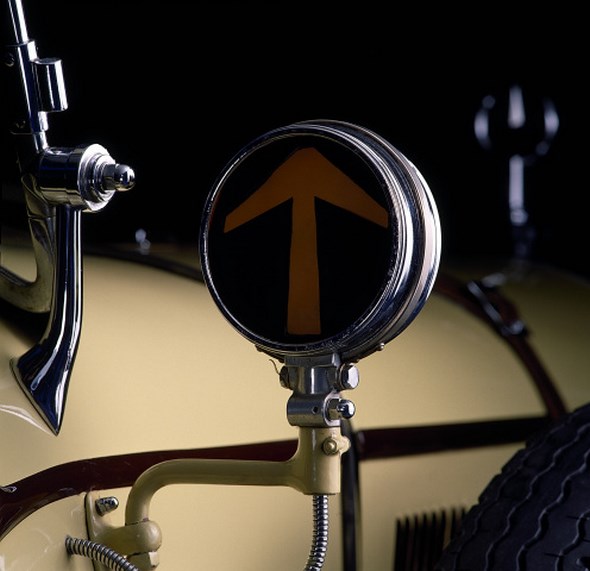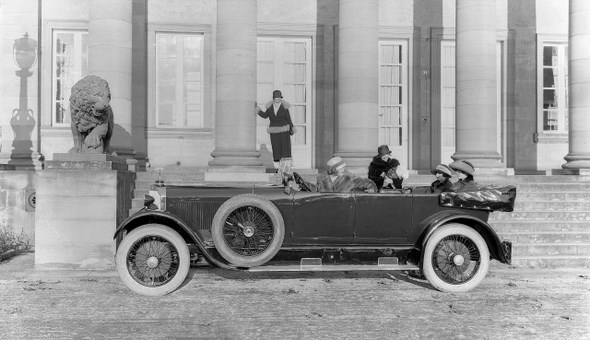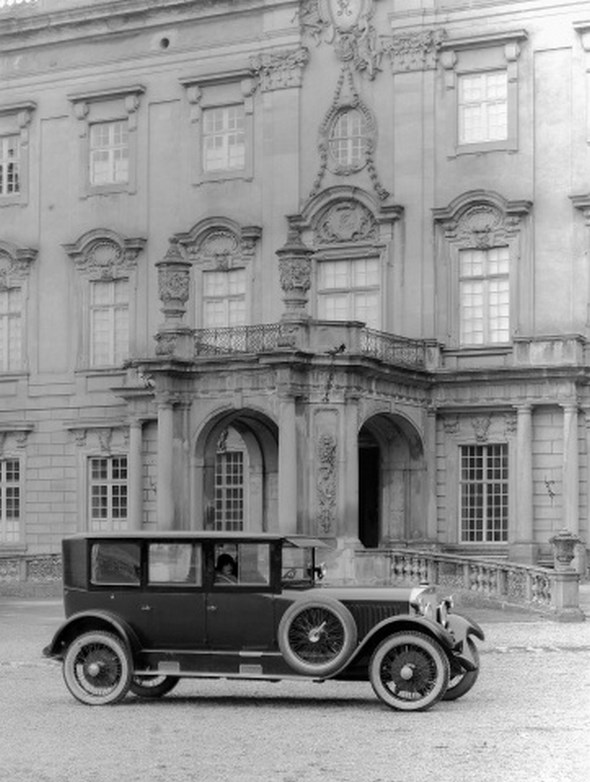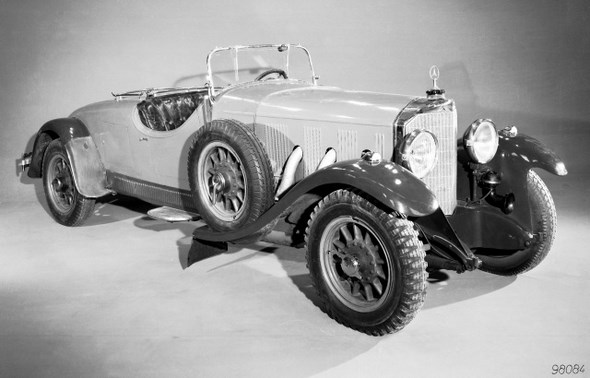Mercedes Model K 1924 – 1930

15/70/100 hp – MB 24/110/160 hp
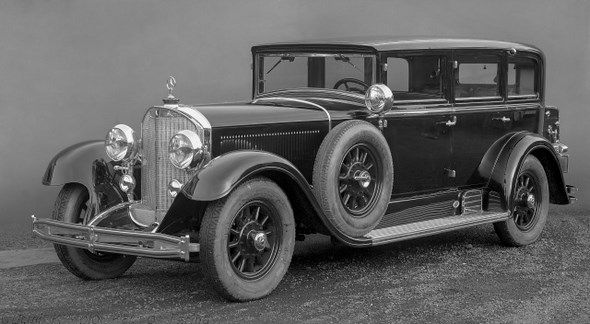
In 1922, there were differences of opinion between chief designer Paul Daimler and the supervisory board of DMG.
Whereas Daimler was intent on developing a new eight-cylinder model, the supervisory board wanted him to come up with a readily marketable mass-production car.

As a consequence of this difference of outlook, Daimler left the company his father had founded and joined the automobile manufacturer Horch in Zwickau, where he was able to realise his eight-cylinder project.
He was succeeded at DMG by Ferdinand Porsche, who became head of the design office on 30 April 1923. This was not the first time Porsche had followed in the footsteps of Paul Daimler, having done so 17 years previously – as technical director at DMG’s Austrian subsidiary in Wiener Neustadt.
Sticking with the supercharger technology introduced by Paul Daimler, Porsche set about developing two new racing cars as well as two high-end passenger car models.
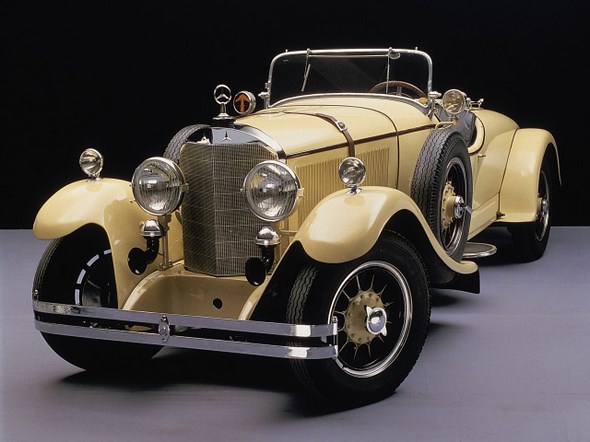
It was in 1924, the same year in which DMG embarked on a joint venture with its long-standing rival Benz & Cie., that the work of the new chief designer bore its first fruits.
The two‑litre four-cylinder racer developed from the previous year’s Indianapolis car under Porsche’s direction won Sicily’s demanding Targa Florio with Christian Werner at the wheel.
There was a less felicitous outcome for the newly designed two‑litre eight-cylinder racer on its first outing at the Italian Grand Prix in Monza: Count Zborowski having left the track and suffered fatal injuries in one of the cars, race director Max Sailer immediately pulled the other two Mercedes out of the race.

Yet from mid-1925 onwards, the eight-cylinder racing car, too, was to achieve considerable success.
Porsche’s newly designed passenger cars were likewise powered by supercharged engines. Although the 15/70/100 hp and 24/100/140 hp models were exactly midway between the two racing cars in terms of number of cylinders, their respective displacements (4.0 and 6.3 litres) were in both cases significantly higher.
As was common practice at that time, the model designations were made up of a first number, which stood for “fiscal horsepower” (based on engine displacement), and a second number, which represented the effective engine power.
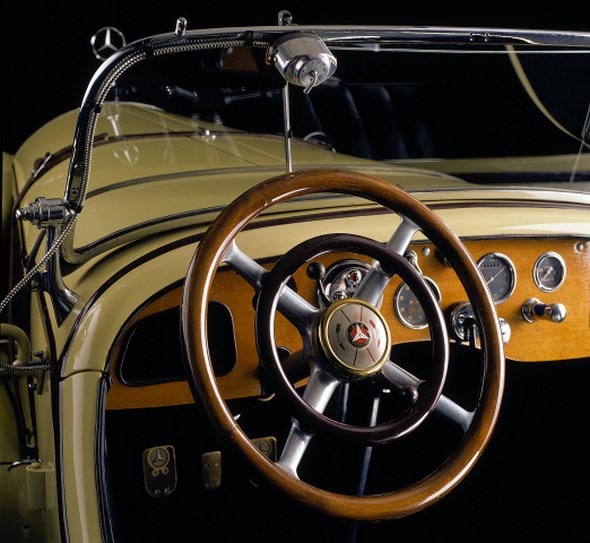
A third number applied exclusively to supercharged vehicles, in which case it denoted the power delivered by the engine with the supercharger in operation.
The in-house model codes, essential for efficient product documentation, were W 836 and W 9456. They were consistent with the nomenclature system introduced at DMG in 1922, which was based on the company’s long-established engine codes.
The chassis simply used the same designation number as the engine, the only difference being that the initial “M” (for Motor – German for engine) was replaced by a “W” (for Wagen – German for car).
The code number itself was made up of a systematic combination of cylinder dimensions and number of cylinders. For example, M 836 meant a bore of 80 mm (Ŝ” in first place) and a stroke of 130 mm (ŗ” in second place).

The third digit Ś” denoted the number of cylinders. In this system, M 9456 meant a six-cylinder engine with a bore of 90 mm and a stroke of 145 mm.
In terms of technical design, the two six-cylinder models were broadly identical. Apart from the engine, the only differences related to the wheelbase, overall length and some bodywork details.
Just like the 6/25 hp and 10/40 hp four-cylinder models unveiled by DMG at the end of 1921 as the company’s first series-produced supercharged passenger cars, the two six-cylinder supercharged vehicles were also powered by engines of exceptionally modern design.

Although, as in the four-cylinder models, the overhead camshaft was driven by a vertical shaft, it was housed inside a removable cast-iron cylinder head.
Similarly, cast iron was the material of choice for the cylinder liners, which were fitted into the light-alloy engine block. In contrast to the individually machined steel cylinders that were welded to the cylinder head on the four-cylinder models, Porsche’s designs were far better suited to mass production.
The new Mercedes six-cylinder models played a key part in the restructuring of the production programme, a task DMG had embarked on even before entering into its alliance with Benz & Cie.

The standardisation and modernisation of the product range took on an even greater importance in the context of the Daimler-Benz joint venture and was expedited with top priority from the very beginning.
Alongside the two luxury-class automobiles, Stuttgart was also developing a two‑l itre model which, although designed according to similar principles, was not yet so far advanced.
Its high production costs meant that the technically sophisticated design was not entirely suitable for a low-cost mass-produced vehicle.
At the end of a long and protracted debate conducted at numerous board meetings, the Mannheim contingent succeeded in forcing through their ideas and in launching the design of a less ambitious, reliable and cheap-to-produce model.

In late 1926, it was not Porsche’s two‑l itre supercharged model, but the 8/38 hp and 12/55 hp that went into production.
The two six-cylinder supercharged models made their debut in December 1924 at the German Motor Show in Berlin, which celebrated its 25th anniversary by inaugurating an additional exhibition hall.
Although originally scheduled for September, the car show had been postponed by two months on account of the unfavourable economic situation.
Having already gone into production in July and September, some of the new Mercedes models were on show in Mercedes sales rooms as early as October.
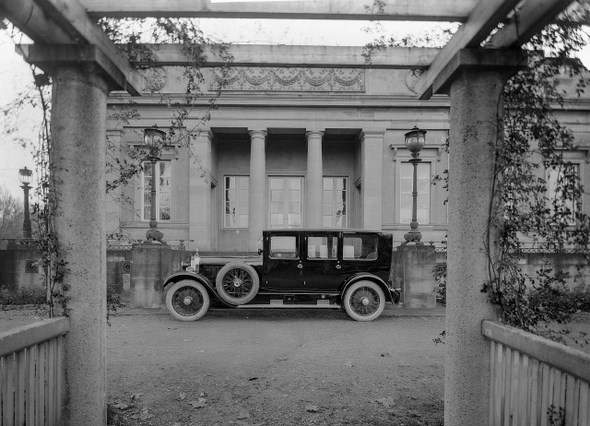
The press release issued at the launch of the new automobiles stated that the “design and technical execution of both chassis and coachwork represent a tremendous step forward in terms of the series production of the motor vehicle.”
As far as performance was concerned, the press release stated: “Thanks to their inherent smoothness and flexibility, combined with fast acceleration and high reserves of power, the two vehicles make an ideal tourer cum sports car, an outstanding hill-climber and -as gear-changing- is required only on exceptionally steep uphill slopes- a most convenient town car for the expert motorist.
From its lowest through to its highest revolutions, the completely silent, carefully balanced engine guarantees an effortless transition and high torque even at low engine speeds.”
Yet it was not just the engineering that came in for praise: “Also the coachwork of the new models represents a significant advance.
Thanks to the amply available length and width, both models allow seven-seater bodies with deep seats and four large doors. The low frame height ensures effortless entry and exit.
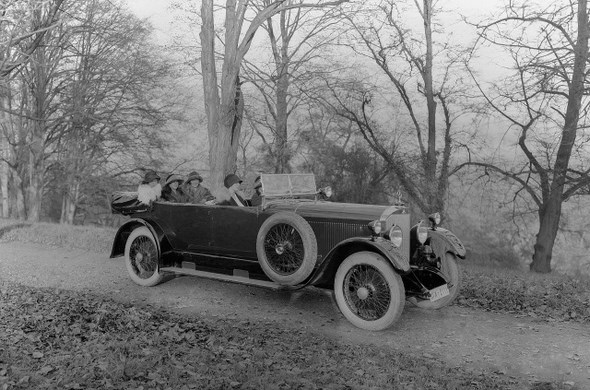
The Mercedes coachwork is the supreme expression of comfort and elegance. It was designed in perfect taste by top artists and manufactured in unsurpassed excellence of workmanship at the coachworks in Sindelfingen.”
Both models were available in a variety of body versions. The choice included open tourers in five‑ or seven‑seater variants, a six-seater coupé touring saloon and a seven‑seater pullman saloon.
The two tourers were also optionally available with a removable pullman top. The most expensive version was the pullman saloon at a price of RM 22,750 for the 15/70/100 hp and RM 27,750 for the 24/100/140 hp.
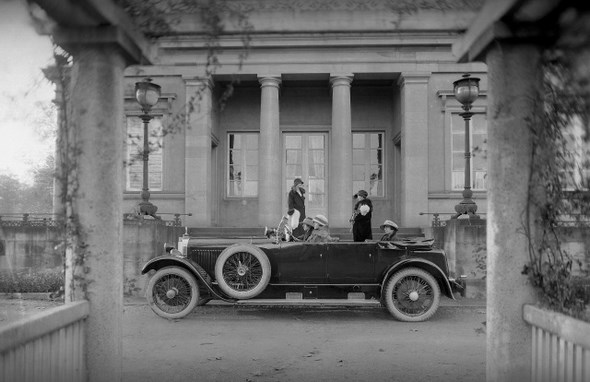
Despite the tastefulness and elegance of the coachwork produced in Sindelfingen, numerous exemplars also left the factory in chassis-only versions to be provided with a wide variety of bodies by renowned coachbuilders both inside and outside Germany.
The list price of the chassis was RM 8,500 less than that of the pullman saloon for both models.
The chassis were not just combined with especially exclusive coachwork creations designed to satisfy even the most outlandish of customer wishes, however.

They also served to meet more mundane needs. For example, the Mercedes 15/70/100 hp could be fitted with a special-purpose body to serve as an ambulance or panel van.
Still more exclusive was a racing transporter based on the 24/100/140 hp, which was constructed in 1924 in line with an idea of Alfred Neubauer and Christian Werner for transporting the eight-cylinder racing car.
Built in September 1926, another one-off production was a chassis with a 650 mm longer wheelbase.
This had been ordered by the US oil millionaire Ellis Treat, whose desire was not for a more spacious coachwork, but for a longer front end. Accordingly, 600 mm of the extra length was taken up by the section in front of the bulkhead, with just 50 mm being added to the passenger compartment.
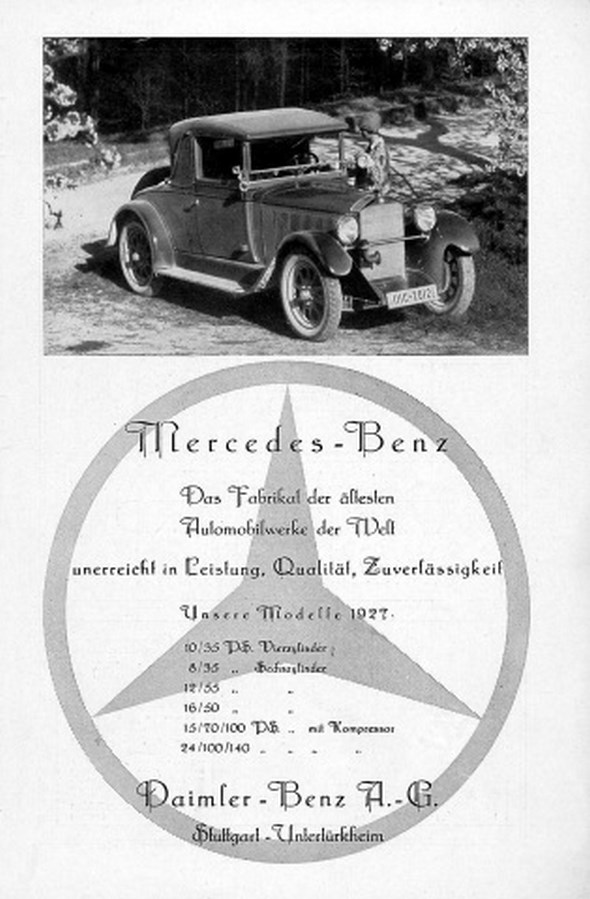
Treat commissioned the Derham Body Company in Rosemont, Pennsylvania, to build him a two-door coupé body, in whose design he actively participated, for his dream Mercedes. This highly unusual vehicle was delivered in January 1927.
The Mercedes 24/100/140 hp was the new top-of-the-line model in the passenger car range. In this respect, it took over from the 28/95 hp, manufacture of which had been discontinued in August 1924.
By December 1924, production of all other Mercedes passenger car models had come to an end. Just two units of the Mercedes Knight 16/50 hp were built in January 1925.

This meant that, from February 1925 onwards, the two six-cylinder supercharged models were Mercedes’s only contribution to the joint venture’s passenger car sales programme.
Benz & Cie augmented the line-up with three passenger car models that, while covering the mid-range segment, were unable to offer the latest available technology.
There was, therefore, a pressing need to renew the mid-range product line-up, something which did not happen until October 1926, however. That month saw the launch of the 8/38 hp and 12/55 hp under the new brand name of Mercedes-Benz, the joint-venture partners having merged in June of that year to form Daimler-Benz AG.
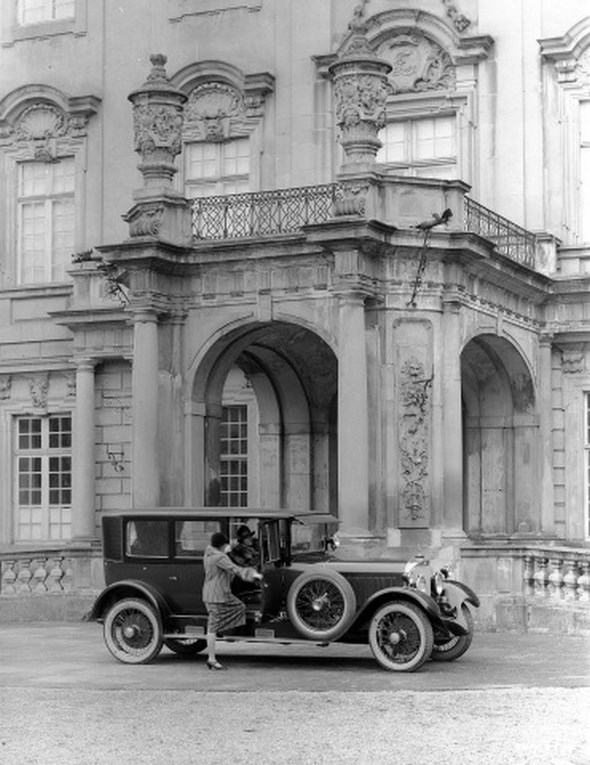
From then on, the new marque was applied also to the previously launched Mercedes and Benz models in the sales programme.
The names of the two six-cylinder supercharged models included the additions Ř litre” and Ś litre”, something that led to frequent confusion in the case of the top-of-the line model, which had a displacement of 6.3 litres from the outset.
Even more confusing was the fact that some in-house documents made reference also to the 600 “model”.
To meet the needs of performance-minded customers, a sporty version of the 24/100/140 hp was developed in early 1926 in the run-up to the merger.
This evolutionary version had a reduced-length chassis with a 350 mm shorter wheelbase and was named the “K” model, the “K” standing for “kurzer Radstand” (short wheelbase).
Apart from the shorter length, the vehicle also featured a technical modification to the rear axle, with the cantilever half-springs on the basic version being replaced on the “K” by conventional underslung half-springs.

The engine included additional modifications: the compression ratio was raised to 5.0 and the high-voltage magneto ignition was augmented by battery ignition, which supplied a second set of spark plugs.
Despite these performance-enhancing measures, the model designation of the “K” retained the technical data of the basic version.
There is no documented reason for this decision; nor is it possible from a present-day perspective to understand why the model designation was not changed.
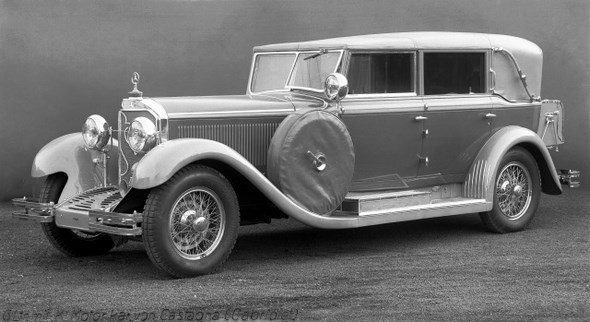
It was early 1929 before the model designation was changed to 24/110/160 hp “K” model.
In the spring of 1926, orders were received for 20 units of the “K” model. The first vehicles were delivered as early as May of that year, even though the new top-of-the line model was not part of the official sales programme and did not even figure in the price list.
Some of the buyers, including the privateer Ernst Günther von Wentzel-Mosau, lost no time entering the new high-performance sports car in motor sport events.
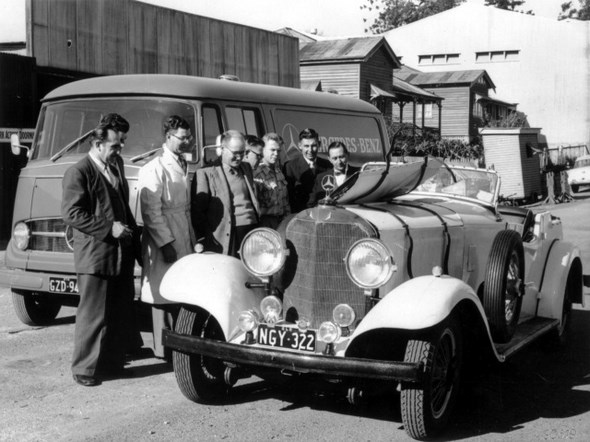
The desired success on the race track was not long in coming. Similarly positive experiences were enjoyed by the DMG works team, which, in May/June 1926, successfully entered the “K” in the Hohnstein Hill Climb Race, Baden-Baden Automobile Tournament and South German Touring Race.
A much-acclaimed international triumph was recorded by Otto Merz, Rudolf Caracciola and Christian Werner with their triple victory in the 12‑hour race of the Guipuzcoa Grand Prix for touring cars in San Sebastian, Spain.
This was followed by numerous further successes in domestic and international competitions.
The press release issued on the occasion of the Berlin Motor Show in October 1926 proudly proclaimed: “To satisfy the special needs of the gentleman driver desirous of participating in sporting competitions, Daimler-Benz A.G. has brought out the six-litre Model “K”, which has a peak performance superior to even that of the standard model. […]
It has a top speed of approximately 155 km/hr, with special importance having been attached also to maximum reliability of the engine over long distances.
The superiority of this vehicle on the international stage is best demonstrated by its numerous successes in speed and reliability competitions as well as by its countless record victories both on the flat and in hill climbs.

It is especially noteworthy that, in the Solitude Race of 1926, this standard-production tourer was able to defeat the entire field of specialist sports cars and racers on both total time and lap time.
The two participating cars crossed the finishing line just seconds apart and in front of all the rest.”
Already prior to the Berlin Motor Show, which was the occasion of the above press release, and also in the months that followed, independent English motoring magazines such as “The Auto”, “The Autocar” and numerous other publications expressed extremely enthusiastic opinions on the performance of the top-of-the-line Mercedes model.

The full brochure of the range of Mercedes-Benz passenger cars from February 1927, in which the “K” was included for the first time, summed up the vehicle’s key attributes: “Fastest touring car in the world! Superior top speed, maximum reliability. Winner of numerous competitions!”.
A special feature of the new exclusive model was the outboard exhaust pipes, which, trimmed with metal tubes, had marked the exterior appearance of particularly sporty and high-performance models since the days of the Mercedes 37/90 hp.

On the “K”, in contrast to all earlier models, the exhaust pipes were on the right-hand side of the engine bonnet, where they were to remain on all subsequent models.
The fact that this impressive design feature was to be found on the majority of supercharged cars, whereas it was absent from most naturally aspirated models, does not justify the – unfortunately widespread – conclusion that this was a design characteristic of Mercedes-Benz supercharged models.
In contrast to the “K”, the basic 24/100/140 hp and the smaller 15/70/100 hp were not normally fitted with outboard exhaust pipes, although they sometimes also featured this design detail – even before the “K” made its first appearance, as is demonstrated by clearly datable photos.

In the autumn of 1927, this feature introduced with the “K” then became part of the standard equipment of the entire model series.
At the same time, all members of the model series began to employ the rear-axle suspension used on the “K” model, with the original cantilever springs being replaced by underslung half-springs.
An exterior detail distinguishes the two versions before and after this technical modification: the first version with cantilever springs has a small opening in front of each of the rear wings just above the side running board, these openings affording access to grease nipples for lubricating the spring mountings.
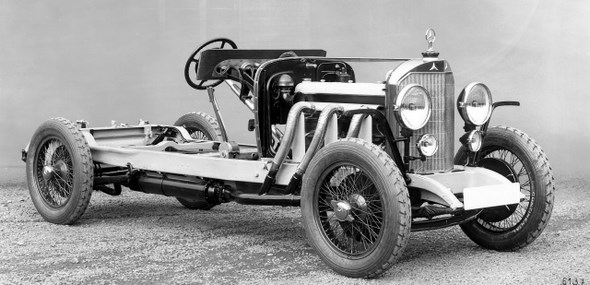
On later vehicles with underslung half-springs, these openings were replaced by a lockable flap that concealed two grease nipples for the front spring shackle.
In February 1928, all Mercedes-Benz passenger cars were given new model designations that were easier to use than the decades-old hp data. In production since 1924, the two six-cylinder supercharged models were now called the 15/70/100 hp 400 model and 24/100/140 hp 630 model or, for short, 400 and 630.

The new designations formed the basis of the system that is still more or less in use to this day, in which a three-digit number – multiplied by 10 – denotes the displacement in cubic centimetres.
From October 1928, at surcharge of RM 2000, the Model 630 was optionally available with the higher-powered engine from the Model “K”.
The brochure noted in grandiose terms: “Our six-litre model is now additionally available with an open tourer body and the higher-powered engine from our K model.
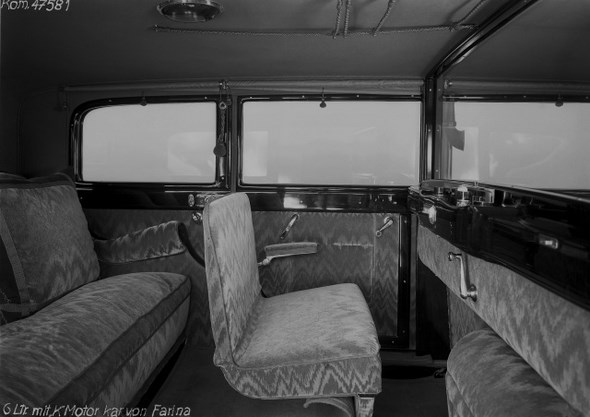
We thus offer an especially competitively priced grand tourer which, in combination with spacious six-seater coachwork, guarantees a particularly high average speed.
To satisfy the needs of the especially discerning client, we also offer this model, at a special price, with a particularly elegant custom-made coachwork as a supreme masterstroke of automotive engineering excellence.”
Here, however, “special price” did not mean a special offer in today’s sense, but a price higher than the normal list price.

October 1928 also saw changes to the choice of coachwork available for the 400 and 630 models. The five‑seater tourer and coupé touring saloon were dropped, as was the removable pullman top, while a four-/five‑seater convertible and a six-/seven‑seater pullman convertible were added to the product range.
The pullman saloon boasted a stylistically modernised form. The original version “with wide, elegant door pillars” was reduced in price by RM 2,750, while the new model “with narrow, especially elegant door pillars” was available at the old price of RM 27,750.

Autumn 1928 marked a watershed, in more ways than one, in the development of the 4‑litre and 6.3‑l itre models. In October, the 400 gave way to the eight-cylinder Nürburg 460, which, although having no supercharger and not being quite so spacious, produced significantly higher torque at low engine speeds while at the same time being considerably lower in price.
These advantages likely compensated for the fact that, with its supercharger in operation, the 400 was able to deliver 20 hp more than its successor.
Production of the four‑litre six-cylinder model was significantly cut back in September 1928 before being phased out entirely in February 1929 after a total of 1,943 vehicles had been manufactured.
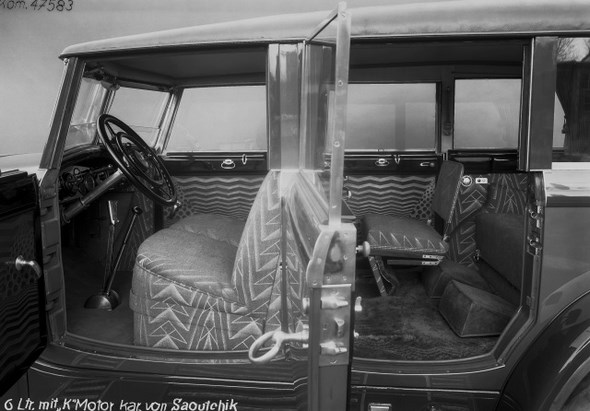
The February 1929 price list was the last to include the Model 400.
Production of the “K” in Untertürkheim had been discontinued in August 1928 as, with the introduction of the “S”, a higher-powered successor had been available for over a year.
Even so, one exemplar of the high-performance sports car was produced in each of December 1928, April and May 1929. The “K” model achieved reached a total production volume of 150 vehicles.
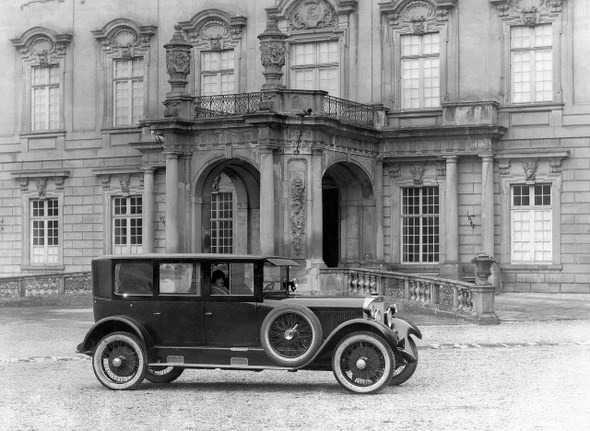
It now being possible to order the 630 with the higher-powered “K” engine, customers switched their focus to the higher-performance version, which, although more expensive, was evidently more attractive.
Production of the standard 6.3‑litre model was thereupon reduced before being phased out entirely in July 1929. The period between October 1928 and July 1929 saw the production of a further 37 vehicles in total, compared with 65 “K”-engined units during the same space of time. T
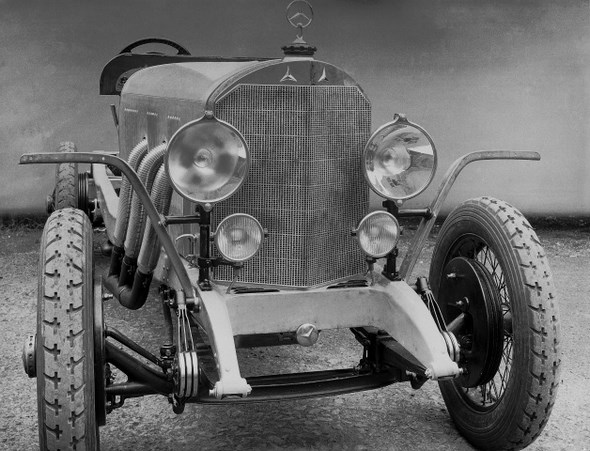
his brought total production of the standard 630 to 1,033 units. The “K”-engined 630 was manufactured up until April 1930. According to official production statistics, a further two vehicles were built in November and December, making for a total production run of 117 vehicles.
All the 6.3‑litre versions – 630, “K”-engined 630 and “K” – were included in the price list until February 1930. Sales after the end of production were clearly somewhat sluggish, with the February 1931 price list offering the still unsold units at reduced prices.
The 400 was available at a standard price of RM 9,000, with the 630 on offer at RM 14,000, while the price was raised by RM 1,500 for vehicles with the “K” engine.
There is no simple answer as to what succeeded the 630: candidates include the “Grand Mercedes”, which was unveiled in October 1930, and the five-litre version of the Nürburg, which was available from February 1931.
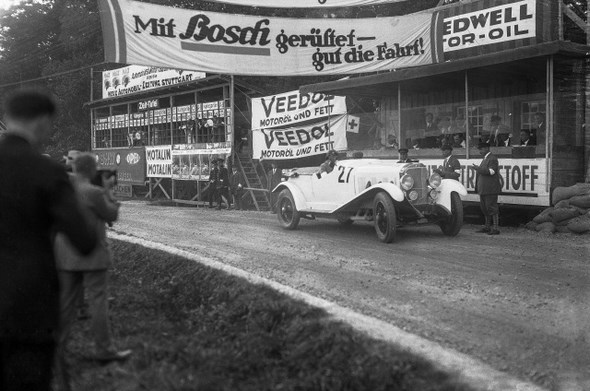
Both models were less progressive in design than the 24/100/140 hp had been in 1924; nor were they able to cover the entire spectrum of the 630. Although the Nürburg 500 was equally spacious and luxurious, and was also over 30% cheaper, it lacked prestigious appeal as well as the added power of the supercharger.
The “Grand Mercedes” embodied the other extreme: more spacious, more luxurious and more powerful, it cost over 50% more than the 630.
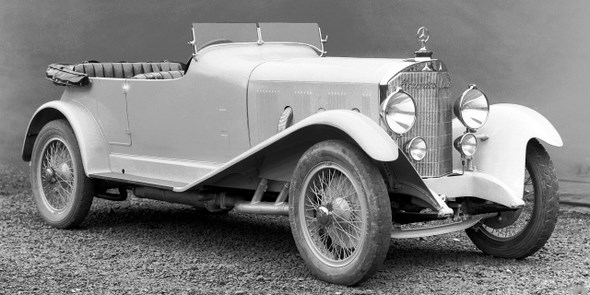
The six-cylinder supercharged cars launched in 1924 occupy a special place in the product history of the Mercedes and Mercedes-Benz brands.
Firstly, they paved the way for supercharger technology to finally make its breakthrough into series production. Secondly, they formed the design basis for the legendary “S” series models, which have done more than any other model series to shape the image of the brand with the star.

While the first generation of six-cylinder supercharged automobiles is today among the most sought-after of collectors’ vehicles, the 6.3‑litre models are somewhat overshadowed by the more exclusive, higher-powered and more famous “S”, “SS” and “SSK” models.
It is sometimes forgotten that, without the 24/100/140 hp, the “S” series would never have existed.

